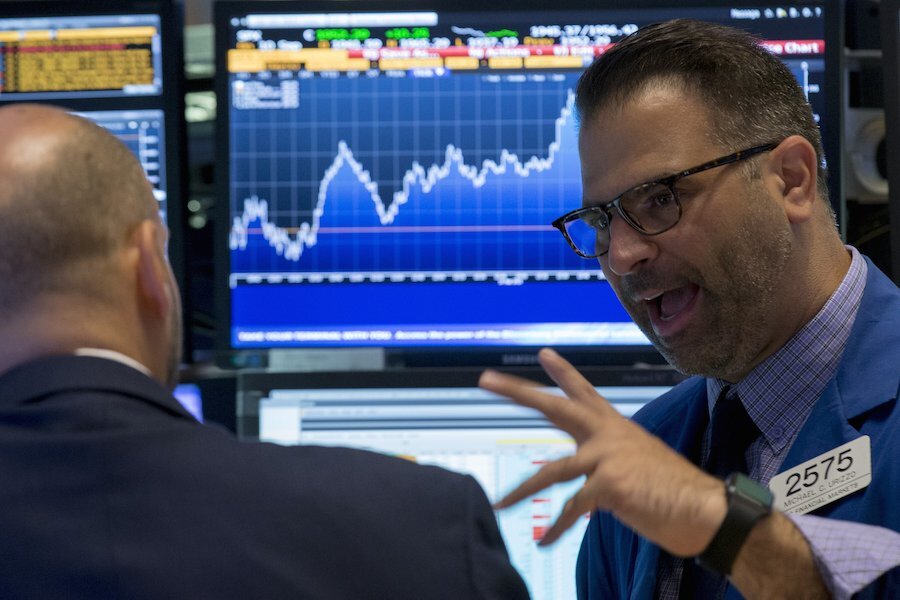Time to get used to a bumpy stock market. Again
Loading...
The stock market has been the surest thing in the investing world over the past several years, offering up big rewards without much of the risk that usually goes along with it. Returns on the Dow Jones Industrial Average have more than doubled since 2009, doing so without a major correction along the way. That lucrative calm held well into 2015: In the first six months of the year, the Dow was never up or down more than 3.5 percent in a single day – a record.
Those years of steadiness have made the past few weeks all the more stomach-churning. On Aug. 24, a sell-off in China’s markets sent the Dow plunging over 1,000 points and the S&P 500 into correction territory for the first time since 2011. Wild swings became commonplace in the days that followed (a 500-point loss here, a 300-point gain there).
The CBOE’s Volatility Index, a popular measure of instability on the S&P 500, has increased 120 percent over the past month. Additionally, “all or nothing days” on the S&P 500, where 400 of the 500 stocks on the index move up or down in tandem, have become a regular occurrence. There have been 11 “all or nothing” days since late August – there were 13 in the first six months of 2015, according to research from the Bespoke Investment Group, released last week.
This is more than a case of momentary jitters, analysts say. For one, the economic turmoil in China that sparked the sell-off in the first place is still a question mark, despite officials recently announcing stimulus efforts to kick-start growth. The country’s main stock index is down about 40 percent since June, and the nation devalued its currency last month for the first time in nearly two decades. “We suspect China is slowing down more than the government is saying,” says David Joy, a Boston-based market adviser for Ameriprise Financial, echoing concerns about the nation’s relative lack of transparency.
The bigger culprit, however, is on the domestic front, in the timing of the Federal Reserve’s increase in long-term interest rates (the first in nearly nine years). The issue isn’t so much the hike itself, which the Fed has been hinting at for several months and will be very minor, initially. It’s that no one can agree when it will actually happen. The Fed meets Wednesday and Thursday this week.
“About a third of the people believe the Fed will raise rates this week, a third in December, a third next year,” says Chuck Self, chief investment officer at iSectors, a quantitative modeling service for financial advisers based in Appleton, Wis. “Given that lack of consensus, every indicator, data release, and governor's speech, is going to cause volatility.”
Recent economic releases, including the August jobs report and second quarter gross domestic product, have been upbeat, but not enough to swing opinion one way or another. But beyond that, there’s the question of whether the markets can continue the impressive growth of the past half-decade when monetary policy is further normalized. “The Fed has been shoving liquidity into this economy at extraordinary amounts, and it has found its way into financial assets,” Mr. Joy says, and created a floor that has limited the volatility normally characteristic in the stock market’s day-to-day movements.
The rates question could be answered within days, at the end of the Fed’s September meeting. But even so, investors should reacclimate themselves to market volatility because it’s far more the norm than the calm of the past few years. “This isn’t unusual,” Mr. Self says. He points out that the height of the tech boom, between 1995 and 1999, had three market dips of 10 percent or more. “It’s just been so long since we’ve had [a correction], that people have forgotten what it feels like. Young investors, if you started in the past six years, you’ve never seen this before.”
Despite the turmoil, neither he nor Joy believe this is the start of a downturn, and they advise investors to keep their long-term goals in mind. “The Fed wouldn’t raise rates if they didn’t feel the recovery was sustainable, and it probably has a few years left to run,” Joy says. “If you’re worried, go back and revisit your portfolio and make sure you’re diversified in case of another down leg. But look beyond the short term.”








